The floors of a ship are called decks, the walls are called bulkheads, and the stairs are called ladders. There are no halls or corridors in a ship, only passageways. There are no ceilings in a room, only the overhead in the compartment. Openings in the outside of the ship are ports, not windows. Entrances from one compartment to another are called doors. Openings from one deck to another are called hatches. The handles on the watertight hatch or door are called dogs.
When you close a door or watertight hatch, you secure it. If you close down the dogs on the door or hatch, you dog it down. You never scrub the floor or wash the walls, rather you swab the deck and scrub the bulkheads. When you get up to go to work, turn to. You never go downstairs, you lay below, and if you are going up from one deck to another, you lay topside. If you are going up the mast or into the rigging you are going aloft.
Unlike a market economy in which new design is a response to a perceived market need, new ship design is typically in response to an expressed need coming from such sources as the advent of new technologies, changes in world politics, new strategies and, lessons learned from previous ship development. This need is identified by Naval planners in the form of a design brief, which will be the basis for subsequent development. This brief will be taken up by designers, who will explore ways in which the design brief can be met, and will eventually develop the most promising of these into detailed instructions for manufacture. In this effort, they will be assisted by design analysts, who use analysis and simulation techniques to test the fitness for purpose of the design proposals, and development engineers who carry out experimental work on the test rigs and on prototypes to make detailed refinements of the design. This group will be supported by research engineers, who carry out experimental or theoretical work to fill in gaps in understanding of materials, processes, or techniques. The ship design spiral process focuses on what the ship needs to carry. Typically ship machinery is dictated and the owner has decided to buy a certain type of engine or the Navy has a certain machinery system which plays a very important parameter in terms of cost and complexity. From there, the shape of the hull form and displacement are considered, because the ship has to float. "TGIF, to a naval architect does not mean Friday, it means floats," Day added. Then the next step, in ship design, is powering. Existing machinery and fuel conservation must be considered with waves and stability. With the advent of computer-aided design and concurrent design, many of these tasks are completed simultaneously. The design of a naval warship is one of the most complex tasks with which an engineer can be involved. The process involves to the synthesis of an enormous variety of intellectual inputs to develop an efficient and effective weapons platform, capable of operating in an increasingly hostile environment. The genesis of a naval warship design lies in the desired functions and performance of the vessel against a perceived threat. The naval design function commences with the analysis of this requirement with the purpose of developing a variety of conceptual solutions, ranging from the conservative to the abstract and encompassing the latest technological advances and developmental research. These studies include:- number and mix of platforms;
- inter-relationship with existing defence equipment, equipments and facilities;
- weapon types and combinations;
- alternative hull form configurations and sizes.
- operational capability;
- technological risk/engineering complexity;
- cost (acquisition and through-life).
- individual components of the weapon system and system configuration;
- optimisation of the hull form with respect to powering, seakeeping and stability;
- ship signature reduction methodologies;
- propulsion machinery alternatives; and
- manning/automation.
- topside arrangement including antenna arrangement, combat system equipment locations and weapon firing arcs;
- main and auxiliary machinery space arrangements;
- command and control compartments including the bridge;
- weapons compartments; and
- flight deck and hanger layout.
- all compartment arrangements;
- system specifications including performance of all equipments and associated integration details, design and construction standards, shock specification, availability, reliability and maintainability;
- full engineering analysis including weapon performance characteristic modelling, ship structural analysis, noise and vibration analysis, hydrodynamic assessment including model testing, weight and stability assessment;
- ensuring sufficient post-damage stability and watertight integrity;
- minimising the weapon impact through ballistic protection, shock protection, use of separation and design of redundant systems;
- maintaining structural integrity through ultimate strength techniques and use of box girder structures;
- selecting appropriate materials of construction and outfit, providing damage control strategies, and designing autonomous and semi-autonomous safety systems.
Ship design followed a pattern of mimicking the previous design for many, many years. Hull forms in the late 19th Century were direct descendants of the previous hull forms, all at full-scale ship size.
A turning point of the hull form development for hydrodynamics was the David Taylor Model Basin Model 632, the parent form of the Taylor Standard Series. The three parameters (displacement length ratio, beam draft ratio and prismatic coefficient) drives most resistance characteristics. Admiral Taylor tested these characteristics and developed a series of contours of resistance-per-ton for various parameter values and speeds. The characteristics have been digitized and re-analyzed for a different extrapolation method, but they are still used today for assessing hull form shape. Taylor also investigated the bulbous bow configuration, a remnant from the ram bow configurations of early steam warships. The bulb generates a wave system that interacts with the wave system of the hull so that the resistance at a particular Froude number (or a particular speed) will be reduced. Modern experiments complement calculations of wave resistance reduction due to bulbous bows. Prediction of drag on a ship hull is always a challenging task for a naval architect. At the start of the design process, hull forms are developed given certain requirements. One of the major design tasks is to estimate the powering performance so that propulsion requirements can be determined. Early estimates of resistance and power are often based on simple empirical formulas derived from data for similar ships. As the design process proceeds, a more reliable approach becomes necessary to predict resistance; scale-model testing has been generally adopted for this purpose.A long and heavy displacement ship tends to be more expensive. For example, the nuclear cruiser California Class (CGN-36) displaced 10,600 tons, carried one gun and two missile-launchers, and was considered a rather large ship for the weaponry onboard. In today's environment one moves towards shorter hull forms. For example, DDG-51 is a shorter hull than DDG-963, but with equal seakeeping performance
STRUCTURAL PARTS OF THE HULL
The hull is the main body of the ship below the main outside deck. The hull consists of an outside covering (or skin) and an inside framework to which the skin is secured. The skin and framework are usually made of steel and secured by welding. However, there may still be some areas where rivets are used. The steel skin may also be called shell plating.
The main centerline structural part of the hull is the keel, which runs from the stem at the bow to the sternpost at the stern. The keel is the backbone of the ship. To the keel are fastened the frames, which run athwartship. These are the ribs of the ship and gives shape and strength to the hull. Deck beams and bulkheads support the decks and gives added strength to resist the pressure of the water on the sides of the hull.
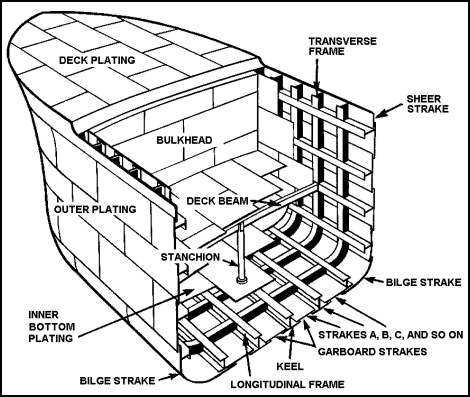
Construction of a Hull
SKIN
The skin, or shell plating, provides water-tightness. The plates, the principal strength members of a ship, have various thickness. The heaviest plates are put on amidships. The others are put on so that they taper toward both ends of the ship (from the keel toward the bilge and from the bilge toward the upper row of plates). Using plates of various thickness reduces the weight of the metal used and gives the vessel additional strength at its broadest part. The plates, put on in rows from bow to stern, are called strakes. They are lettered consecutively, beginning at the keel and going upward.
STRAKE NAMES
The bottom row of strakes on either side of the keel, are called garboard strakes. The strakes at the turn of the hull, running in the bilge, are bilge strakes. The strakes running between the garboard and bilge strakes are called bottom strakes and the topmost strakes of the hull are sheer strakes. The upper edge of the sheer strake is the gunwale.
BULKHEADS
The interior of the ship is divided by the bulkheads and decks into watertight compartments. A vessel could be made virtually unsinkable if it were divided into enough small compartments. However, too many compartments would interfere with the arrangement of mechanical equipment and the operation of the ship. Engine rooms must be large enough to accommodate bulky machinery. Cargo spaces must be large enough to hold large equipment and containers.
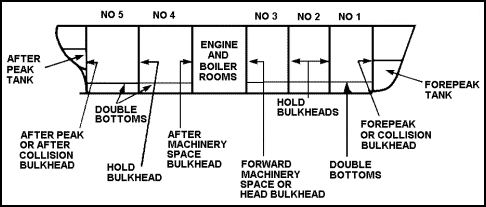
Bulkheads and Decks
ENGINE ROOM
The engine room is a separate compartment containing the propulsion machinery of the vessel. Depending on the size and type of propulsion machinery, other vessel machinery may be located there (such as generators, pumping systems, evaporators, and condensers for making fresh water). The propulsion unit for Army vessels is a diesel engine. The "shaft" or rod that transmits power from the engine to the propeller leads from the aft end of the engine to the propeller.
EXTERNAL PARTS OF THE HULL
The waterline is the water-level line on the hull when afloat. The vertical distance from the waterline to the edge of the lowest outside deck is called the freeboard. The vertical distance from the waterline to the bottom of the keel is called the draft. The waterline, draft, and freeboard will change with the weight of the cargo and provisions carried by the ship. The draft of the ship is measured in feet and inches. Numbered scales are painted on the side of the ship at the bow and stern.
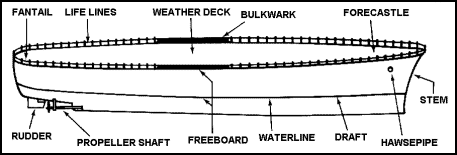
External Parts of the Hull
The relationship between the drafts at the bow and stern is the trim. When a ship is properly balanced fore and aft, she is in trim. When a ship is drawing more water forward than aft, she is down by the head. If the stern is too far down in the water, she is down by the stern. If the vessel is out of balance laterally or athwartship (leaning to one side) she has a list. She may be listing to starboard or listing to port. Both trim and list can be adjusted by shifting the weight of the cargo or transferring the ship�s fuel and water from one tank to another in various parts of the hull.
The part of the bow structure above the waterline is the prow. The general area in the forward part of the ship is the forecastle. Along the edges of the weather deck from bow to stern are removable stanchions and light wire ropes, called life lines. Extensions of the shell plating above the deck are called bulwarks. The small drains on the deck are scuppers. The uppermost deck running from the bow to the stern is called the weather deck. The main deck area over the stern is called the fantail or poop deck. The flat part of the bottom of the ship is called the bilge. The curved section where the bottom meets the side is called the turn of the bilge.
Below the waterline are the propellers or screws which drive the ship through the water. The propellers are attached to and are turned by the propeller shafts. A ship with only one propeller is called a single-screw ship. Ships with two propellers are called twin-screw ships. On some ships (especially landing craft) there may be metal frames built around the propellers (called propeller guards) to protect them from damage. The rudder is used to steer the ship.
NAMES OF DECKS
The decks aboard ship are the same as the floors in a house. The main deck is the first continuous watertight deck that runs from the bow to the stern. In many instances, the weather deck and the main deck may be one and the same. Any partial deck above the main deck is named according to its location on the ship. At the bow it is called a forecastle deck, amidships it is an upper deck, and at the stern it is called the poop deck. The term weather deck includes all parts of the forecastle, main, upper, and poop decks exposed to the weather. Any structure built above the weather deck is called superstructure.

Weather Decks
SHIPBOARD DIRECTIONS AND LOCATIONS
The front end of the ship is the bow. When you move toward the bow, you are going forward, when the vessel is moving forward, it is going ahead. When facing toward the bow, the front-right side is the starboard bow and the front-left side is the port bow.
The central or middle area of a ship is amidships. The right center side is the starboard beam and the left center side is the port beam.
The rear of a vessel is the stern. When you move in that direction you are going aft, when the ship moves in that direction it is going astern. When looking forward, the right-rear section is called the starboard quarter and the left-rear section is called the port quarter.
The entire right side of a vessel from bow to stern is the starboard side and the left side is the port side. A line, or anything else, running parallel to the longitudinal axis or centerline of the vessel is said to be fore and aft and its counterpart, running from side to side, is athwartships.
From the centerline of the ship toward either port or starboard side is outboard and from either side toward the centerline is inboard. However, there is a variation in the use of outboard and inboard when a ship is on berth (moored to a pier). The side against the pier is referred to as being inboard; the side away from the pier as outboard.

Locations and Directions Aboard Ship
How a Ship is Compartmented and Numbered
Knowing how a ship is compartmented is crucial for navigating its vast interior. Each compartment of the ship is stamped with a series of alphanumeric numbers, known as "bull�s-eyes," which give information on where you are, and what that compartment�s function is. The information is given in the following order: deck number, frame number, relation to the centerline of the ship, and compartment usage. Each of these parts is separated by a hyphen.
Decks above the main deck are numbered 01, 02, 03, etc. and are referred to as levels. Below the main deck, there are the first, second, third decks, etc. (remember, on a carrier the hangar deck, the one below the flight deck, is the main deck.). Frame numbers tell you where you are in relation to the bow of the ship; the numbers increase as you go aft. The third number in the bull�s-eye reflects compartmentation numbers in relation to the ship�s centerline. EVEN numbers are to PORT, and ODD numbers are to STARBOARD. The numbers increase as you travel outboard. The last letter stamped on the compartmentation number indicates what the compartment is used for. Below are some typical codes:
Carrier Compartment Usage Codes
A |
Supply and storage | L |
Living quarters |
B |
Guns | M |
Ammunition |
C |
Ship control | T |
Trunks and passages |
E |
Machinery | V |
Void |
F |
Fuel | W |
Water |
Example Bull’s-eye: 3-75-4-M
3 |
Indicates the third deck. |
75 |
Indicates the compartments forward boundary is on or immediately aft of ship’s frame 75. |
4 |
Indicates the fourth compartment outboard of the centerline to port (even numbers to port, odd to starboard). |
M |
Indicates the compartment is used for ammunition (see above). |

Figure 1.1. Carrier Deck Schematic
Material Conditions
Material Conditions (NWP 3-20.31) establish the fighting integrity of the ship and maintain its survivability. The determination of the material condition set at any time is the responsibility of the Commanding Officer, who may authorize modifications of any material condition.- X-Ray provides the least tightness and the greatest ease of access throughout the ship. It is set when the threat to the ship is minimal, during working hours when in port, or when there is no danger of attack or bad weather.
- Yoke is set when at sea, or in port during wartime.
- Zebra provides the greatest degree of subdivision and tightness to the ship. It is set immediately and automatically when general quarters is sounded. It is also set when entering or leaving port during wartime, to localize damage and control fire and flooding, or at any time the Commanding Officer deems it necessary. Modified Material Condition ZEBRA - allows movement around the ship for special conditions such as: Underway Replenishment (UNREP); Vertical Replenishment (VERTREP); Air Operations; Amphibious Operations; transit of known or suspected hazardous navigation areas.
SHIPBOARD MEASUREMENTS
A ship�s size and capacity can be described in two ways--linear dimensions or tonnages. Each is completely different yet interrelated.
A ship�s measurement is expressed in feet and inches--linear dimensions. A ship is a three dimensional structure having length, width, and depth.
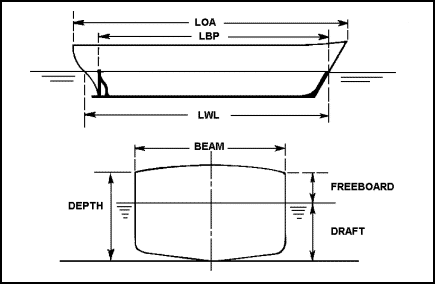
A Ship�s Dimensions
LENGTH
A ship�s length is measured in different ways for ship�s officers, for architects and designers, and for registry. Terms used for technical or registry purposes include registered length, tonnage length, floodable length, and length by ABS rules. We mention these terms for familiarization only. The more commonly used length measurements -- length overall, length between perpendiculars, and length on load waterline are discussed as follows.
A ship�s Length Overall [LOA] is measured in feet and inches from the extreme forward end of the bow to the extreme aft end of the stern. Watercraft operators must be familiar with this and similar dimensions to safely maneuver the ship. The dimension is commonly found in lists of ship�s data for each vessel.
A ship�s length is sometimes given as Length Between Perpendiculars [LBP]. It is measured in feet and inches from the forward surface of the stem, or main bow perpendicular member, to the after surface of the sternpost, or main stern perpendicular member. On some types of vessels this is, for all practical purposes, a waterline measurement.
A ship�s Length on Load Waterline [LWL] is an important dimension because length at the waterline is a key factor in the complex problem of speed, resistance, and friction. On vessels with a counter stern, the LWL and LBP can be the same or about the same. On a ship with a cruiser stern, the LWL is greater than the LBP, as shown in the top portion of Figure 3-6.
WIDTH
A ship�s width or, more properly, a ship�s breadth is expressed in a number of ways and, like length, for a number of reasons.
A ship�s extreme breadth, commonly called beam, is measured in feet and inches from the most outboard point on one side to the most outboard point on the other at the widest point on the ship. This dimension must include any projections on either side of the vessel. Like length overall, this measurement is important to a ship�s officer in handling the vessel.
DEPTH
The depth of a vessel involves several very important vertical dimensions. They involve terms like freeboard, draft, draft marks, and load lines. The vessel�s depth is measured vertically from the lowest point of the hull, ordinarily from the bottom of the keel, to the side of any deck that you may choose as a reference point. Therefore, it has to be stated in specific terms such as depth to upper deck amidships. It is impractical to measure depth in any other way, since it varies considerably from one point to another on many ships. For example, the depth is greater at the stern than amidships.
The term "depth" is where the measurement is taken from the bottom--from the keel upward. Ordinarily, if such a measurement were being made in a room of a building, taken from the floor to the ceiling, it would be called height.
PROCEDURE FOR READING DRAFT MARKS
Draft marks are numbers marked on each side of the bow and stern of the vessel. Draft marks show the distance from the bottom of the keel to the waterline.
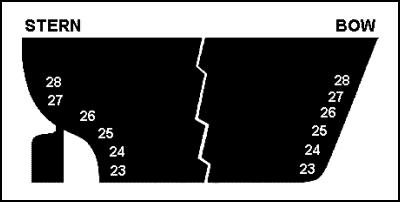
Draft Marks on Bow and Stern of Vessel
The draft numbers shown in the figure are 6 inches high and 6 inches apart. The bottom of each number shows the foot draft mark.
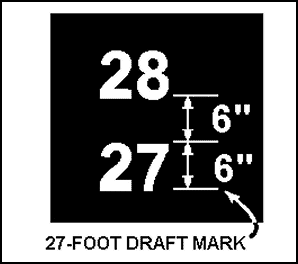
Draft Numbers Showing Foot Draft Mark
The next figure shows four different draft readings.
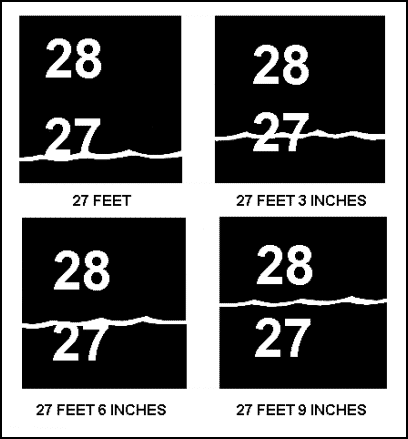
Various Draft Readings
WEIGHT TONNAGE TERMS
The word "ton" comes from the English "tun" meaning cask or barrel. To the English, it meant a wine barrel with a capacity of about 252 gallons. When Parliament imposed duties on the wine entering England in these barrels, the duty imposed on each tun eventually led to the use of tunnage in describing a ship�s capacity to carry such barrels. The original use of tun meant a barrel of a particular size, the space that such a barrel would occupy, and a ship�s capacity to carry a given number of such barrels. Tun was originally a figure for space--not weight. By law, Parliament fixed the tun at 252 gallons. Since this fixed tun weighed an average of 2,240 pounds, it brought into existence the weight term "long ton."
A long ton is used throughout the shipping business. It is not to be confused with the familiar ton of 2,000 pounds, the short ton, used so widely in the US in relation to so many things other than ships and shipping. The metric ton is 1,000 kilograms, the equivalent of 2,204.6 pounds. Tonnages normally refer to the long ton of 2,240 pounds.
DISPLACEMENT, LIGHT - The weight of the ship excluding cargo, fuel, ballast, stores, passengers, crew, but with water in boilers to steaming level.
DISPLACEMENT, LOADED - The weight of the ship including cargo, passengers, fuel, water, stores, dunnage and such other items necessary for use on a voyage, which brings the ship down to her load draft.
DEADWEIGHT - The total lifting capacity of a ship expressed in tons of 2240 lbs. It is the difference between the displacement light and the displacement loaded.
GROSS TONNAGE - The entire internal cubic capacity of the ship expressed in tons of 100 cubic feet to the ton, except certain spaces which are exempted, such as: (1) peak and other tanks for water ballast; (2) spaces above the uppermost continuous deck, such as: open forecastle, bridge and poop, certain light and air spaces, domes of skylights, condenser, anchor gear, steering gear, wheel house, galley and cabins for passengers.
NET TONNAGE - The tonnage most frequently used for the calculation of tonnage taxes and the assessment of charges for wharfage and other port dues. Net tonnage is obtained by deducting from the gross tonnage, crew and navigating spaces and an allowance for the space occupied by the propelling machinery.
CARGO DEADWEIGHT - Capacity is determined by deducting from total deadweight the weight of fuel, water, stores, dunnage, crew passengers, and other items necessary for use on a voyage.
The tonnage of combat ships is expressed in terms of displacement. The tonnage of cargo ships is typically measured measured in terms of deadweight [the net cargo capacity].
CATEGORIES OF SHIP'S DECK GEAR
The term "ship�s gear" is used to describe that gear and equipment aboard ship that is used for cargo transfer activities and deck operations. Ship�s gear can be divided into four categories:
- Standing rigging.
- Running rigging.
- Deck fittings.
- Deck machinery.
STANDING RIGGING
Standing rigging gear includes the rigging that supports masts or king posts. This gear includes the following:
Shrouds are heavy wire ropes that provide athwartship support for the mast or king posts. Two or more shrouds are used on either side of a mast or king post. They are secured to the outboard side of the deck or to the bulwark to provide maximum support.
Turnbuckles are internally threaded collars turning on two screws threaded in opposite directions. They are used to secure and to take up the slack in the shrouds and stays.
Stays and Backstays are heavy wires similar to shrouds. The difference is that they will lead in a forward or aft direction. They are found at the mast where the jumbo boom (heavy lift boom) is located. When they support the mast from a forward direction, they are called stays. When they support the mast from an aft (back) direction, they are called backstays.
RUNNING RIGGING
This gear includes the moving or movable parts that are used to hoist or operate gear (such as cargo runners, topping lifts, and guy tackles).
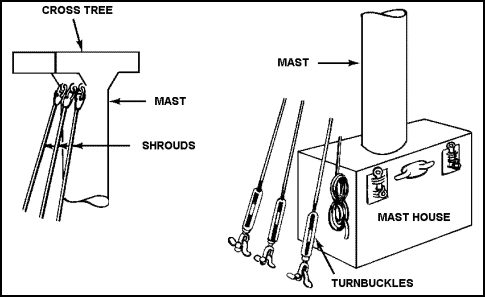
Standing Rigging Gear
DECK FITTINGS
These are the devices that are used to secure standing rigging, running rigging, and mooring lines.
Bitts are heavy metal bed plates with two iron or steel posts. They are used on ships for securing mooring or towing lines. Usually there is a set forward and after each chock.
Chocks are heavy fittings secured to the deck. Lines are passed through them to bollards on the pier. The types of chocks used are closed, open, roller, and double roller.
Cleats are metal fittings having two projecting horns. They are used for securing lines.
Pad Eyes are fixtures welded to a deck or bulkhead. They have an eye to which lines or tackle are fastened and are used for securing or handling cargo.
A bulwark is the wall around any deck exposed to the elements. This includes the weather deck, the poop deck, the fore deck, and any deck on the superstructure. On top of the bulwark is a flat rail (or plate) called the rail. Pad eyes and cleats are often welded to the rail.
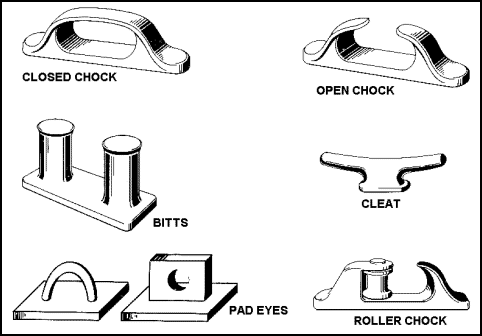
Deck Fittings
DECK MACHINERY
This includes the standard machinery that is found on the decks of Army watercraft. The size and shape of the deck machinery may vary depending upon type of vessel, but the operating principles remain the same.
Cargo Winches are power-driven machines used to lift, lower, or move cargo. Winches are classified according to their source of power. Electric winches are standard equipment on most vessels. An electric winch has a steel base on which the winch drum, motor, gears, shafts, and brakes are mounted. The drum, which has cable wound on it, is usually smooth with flanged ends. It revolves on a horizontal axis and is driven through single or double reduction gears by an electric motor (usually direct current). A solenoid brake and a mechanical brake are fitted to the motor shaft. The winch is located on deck or on a deckhouse. The winch controls consist of a master controller or switchbox located on a pedestal at the end of the hatch square and a group of relays, contactors switches, and resistors located near the winch motor.
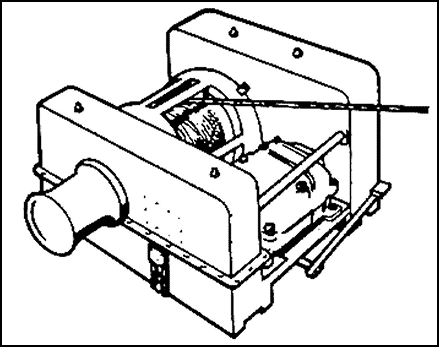
Electric Winch
The Windlass is a special type of winch used to raise and lower the anchors and to handle the forward mooring lines. It consists of a wildcat (a steel casting in the form of a deeply grooved drum with projecting ribs [whelps]) used to grip the anchor chain, controls for connecting or disconnecting the wildcat from the engine, and a friction brake which can be set to stop the wildcat when disconnected. There are horizontal drums at each end of the windlass for warping.
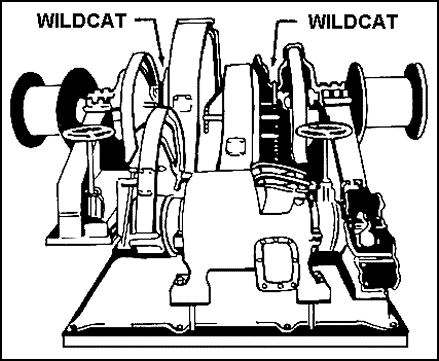
Windlass
The Capstan is a vertically mounted winch head used aboard ship when mechanical power is required for raising anchor, lifting heavy weights, or for any similar work. It is a cast steel drum mounted on a vertical spindle with the largest diameters at top and bottom and the smallest in the middle to allow the rope around it to surge up or down as the number of turns are increased. The drum is fixed to the spindle by keys.
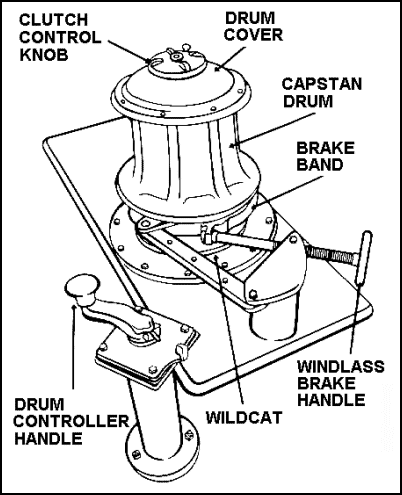
Capstan



